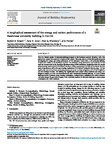A longitudinal assessment of the energy and carbon performance of a Passivhaus university building in the UK
| dc.contributor.author | Korsavi, Sepideh Sadat | |
| dc.contributor.author | Jones, Rory | |
| dc.contributor.author | Bilverstone, PA | |
| dc.contributor.author | Fuertes, Alba | |
| dc.date.accessioned | 2021-10-09T07:01:35Z | |
| dc.date.available | 2021-10-09T07:01:35Z | |
| dc.date.issued | 2021-12 | |
| dc.identifier.issn | 2352-7102 | |
| dc.identifier.issn | 2352-7102 | |
| dc.identifier.other | 103353 | |
| dc.identifier.uri | http://hdl.handle.net/10026.1/18015 | |
| dc.description.abstract |
There is a limited number of university buildings designed to the Passivhaus standard, therefore, only a few studies have assessed the standard's adoption in this context. This paper aims to address this significant gap by investigating the energy and carbon performance of The Enterprise Centre (TEC), a UK university building, designed and certified to the Passivhaus standard. The building's energy performance was monitored for four years and was predicted by the Passivhaus Planning Package (PHPP) simulations. Results show that TEC met the primary energy requirement of 120 kWh/m2 and space cooling requirement of 15 kWh/m2 during the first four years of operation, as well as the space heating requirement of 15 kWh/m2 during the first two years. TEC had significantly reduced heat losses and heating demand, due to the very high airtightness, 0.21 m3/(m2·h) @50 Pa, and low envelope U-values. The building had significantly lower annual carbon emissions and energy consumption compared to CIBSE TM46 benchmarks and other conventional university buildings. TEC is an excellent building in terms of primary energy, heating consumption, cooling demand, airtightness and carbon emissions. This study bridges the gap on the adoption of the Passivhaus Standard for university buildings to reduce energy consumption and carbon emissions. | |
| dc.format.extent | 103353-103353 | |
| dc.language | en | |
| dc.language.iso | en | |
| dc.publisher | Elsevier | |
| dc.rights | Attribution 4.0 International | |
| dc.rights | Attribution 4.0 International | |
| dc.rights | Attribution 4.0 International | |
| dc.rights | Attribution 4.0 International | |
| dc.rights.uri | http://creativecommons.org/licenses/by/4.0/ | |
| dc.rights.uri | http://creativecommons.org/licenses/by/4.0/ | |
| dc.rights.uri | http://creativecommons.org/licenses/by/4.0/ | |
| dc.rights.uri | http://creativecommons.org/licenses/by/4.0/ | |
| dc.subject | Passivhaus standard | |
| dc.subject | Energy demand | |
| dc.subject | Airtightness | |
| dc.subject | Heating consumption | |
| dc.subject | CO2 emissions | |
| dc.title | A longitudinal assessment of the energy and carbon performance of a Passivhaus university building in the UK | |
| dc.type | journal-article | |
| dc.type | Journal Article | |
| plymouth.author-url | https://www.webofscience.com/api/gateway?GWVersion=2&SrcApp=PARTNER_APP&SrcAuth=LinksAMR&KeyUT=WOS:000707021900003&DestLinkType=FullRecord&DestApp=ALL_WOS&UsrCustomerID=11bb513d99f797142bcfeffcc58ea008 | |
| plymouth.volume | 44 | |
| plymouth.publication-status | Published | |
| plymouth.journal | Journal of Building Engineering | |
| dc.identifier.doi | 10.1016/j.jobe.2021.103353 | |
| plymouth.organisational-group | /Plymouth | |
| plymouth.organisational-group | /Plymouth/Faculty of Arts, Humanities and Business | |
| plymouth.organisational-group | /Plymouth/Faculty of Arts, Humanities and Business/School of Art, Design and Architecture | |
| plymouth.organisational-group | /Plymouth/REF 2021 Researchers by UoA | |
| plymouth.organisational-group | /Plymouth/REF 2021 Researchers by UoA/UoA13 Architecture, Built Environment and Planning | |
| plymouth.organisational-group | /Plymouth/Users by role | |
| plymouth.organisational-group | /Plymouth/Users by role/Academics | |
| dcterms.dateAccepted | 2021-09-19 | |
| dc.rights.embargodate | 2021-10-12 | |
| dc.identifier.eissn | 2352-7102 | |
| dc.rights.embargoperiod | Not known | |
| rioxxterms.versionofrecord | 10.1016/j.jobe.2021.103353 | |
| rioxxterms.licenseref.uri | http://creativecommons.org/licenses/by/4.0/ | |
| rioxxterms.licenseref.startdate | 2021-12 | |
| rioxxterms.type | Journal Article/Review |



